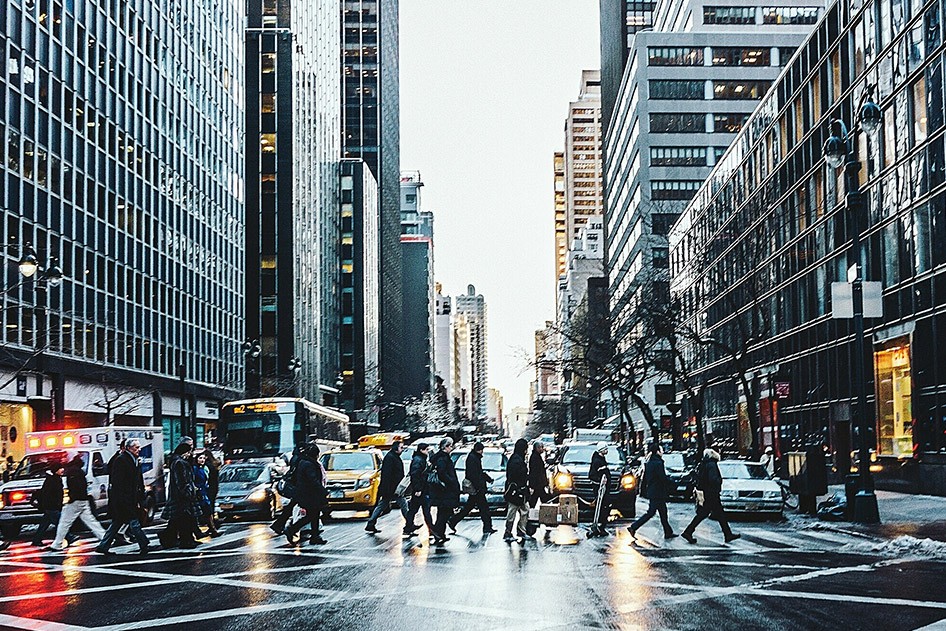
Cities are hard to live in during the summer. To the usual clatter and noise of traffic, busy streets, and the hum of people and building we must add the heat, the higher temperatures. Urban cores, the paved, build up environments where we work and live, get measurably warmer than the countryside. On a warm summer afternoon, what could be a sweltering 30C degree day in the countryside can become a sweltering 34ºC /93.2ºF oven at the city core.
The urban heat island effect is behind this difference. Cities, especially dense, develop areas, tend to trap heat in a variety of ways that contribute to push up the temperature outside. Dark roads and asphalt parking lots retain heat on the ground instead of reflecting it, warming the very ground we walk on. Dark rooftops heat up buildings, making them harder to cool. Buildings themselves either trap heat inside when they are not air conditioned, slowly releasing it at night. Impermeable surfaces reduce air moisture, further increasing temperatures. Vehicles and factories produce heat just by operating, further warming up the air.
In rural or suburban areas, a lot of these effects are mitigated by a simple, old technology: trees. Tree cover produces several effects that contribute to alleviate heat island. First, they produce shade, limiting the amount of heat that reaches the ground. These reduces the amount of heat that is absorbed by the ground itself and radiated back to the atmosphere at night, helping to mitigate warm temperatures. Second, in a process called evapotranspiration, trees act as natural heat exchangers, as the take water up from the ground and release it through the surface of the leaves, naturally cooling the air. Third, they absorb and store carbon dioxide, reducing pollution and limiting greenhouse gases in the atmosphere. Fourth, trees can also offer shade to buildings, reducing energy demand and lowering the load for air conditioners.
These effects, of course, are also present when trees are planted in buildup environments - as a result, increasing tree cover is a simple, direct strategy to reduce urban heat island effects. Studies show that tree canopies are very effective at countering the effect of paved surfaces absorbing and radiating heat. Researchers have found that streets with modestly dense tree cover can reduce air temperatures from 3ºC /37.4ºF to 5ºC/41ºF, effectively turning a hostile stretch of asphalt and concrete to a pleasant shaded place to walk or ride a bike on. Just their presence, and the contrast between shaded and sunny areas, can create temperature gradients that produce a nice breeze. The warmer the city, the stronger the effect, and the bigger the return of investment.
The problem, of course, is that tree planting might be technologically simple, but it is not always cheap. Cities often struggle to maintain, let alone expand, existing tree cover. In urban areas with power lines in utility poles, overeager maintenance crews might see tree cover more as a nuisance than as an asset. Developers will often cut down trees when putting up new buildings; strapped city officials often find forestry budgets more as a luxury good than as an investment. Trees, especially in busy urban streets, require constant care and maintenance. Planting more of them not only requires often disruptive streetscape modifications to accommodate vegetation, but plenty of upkeep and years, even decades, of patience before their shade truly starts making a difference.
To make the problem even more challenging, all trees are not equal in creating cooling effects – and how effective they are greatly depends on their health. To achieve these levels of cooling, however, the tree must be growing up vigorously, and it needs good care, access to water, and a rich soil. The specifics on how effective each tree species is and how much do they cost to grown will be completely different for each city. Getting the right tree mix requires a level of research and attention to detail that not many local forestry departments have or can afford.
As a result, urban greening requires not just a decided effort now, but a constant, methodical, long-term approach to how we plan and build in our urban areas. It forces city planners to look beyond traffic flow, economic development, or property values as of today, but to consider how streetscapes and gardening budgets will impact urban health decades down the road.
All in all, although increased tree coverage is likely a good long-term solution to reduce heat island effects, it needs to be paired with more immediate solutions, like reducing residual heat produced by existing buildings and machinery. Modern air conditioning units, specially high efficiency heat recovery and heat pump systems like the new Hitachi 6-16 ton systems, not only can be designed and build to generate the exact level of cooling required for a building without using excess energy, but to do so at significantly reduced energy budgets compared to older units.
Engineers and architects can reduce the heat signature and energy footprint of their buildings right now, cooling not just the building we work or live in, but the city that surrounds it. While planning long-term for plant-based solutions, cities can retrofit building with modern cooling solutions to increase energy efficiency right now. Any approach to environmental issues requires implementing more than one policy solution, with technology and nature each playing a role.
–Contact
Communications
Johnson Controls-Hitachi Air Conditioning
JPN-pr_inq@jci-hitachi.com


